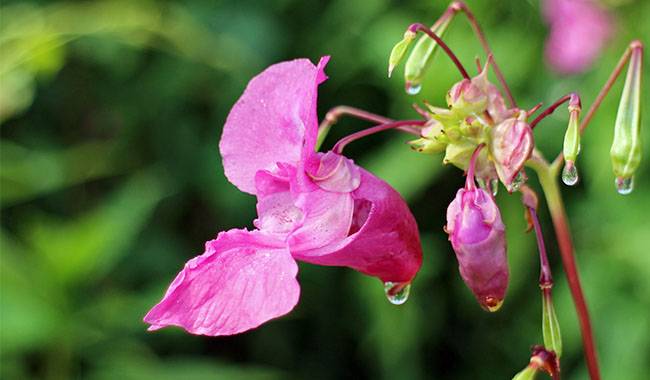
Many people like to decorate their windowsills, yards, and garden plots with ornamental flowers in clusters of large, bright flowers. One of these flowers is Balsam flowers (Impatiens balsamina). About how growing balsam flowers from seeds, as well as its species, how it is used in landscape design – this is what we will talk about in this article.
Balsam flowers, which is also known as Impatiens balsamina or perennial, from the family Impatiens balsamina – it is an annual or perennial herb (garden or room flower), which counts in their genus more than 500 species.
Balsam flower leaves are fleshy, entire, glossy, with serrated edges and glandular at the base. The leaves are green, reddish-green, or bronze in color. The succulent and branched buds of different varieties of Balsam flowers range in height from 6-20inch (15-50 cm).
The flowers are zygomorphic and grow singly or in inflorescences. Each flower is in a leaf axil and can have different colors depending on the variety: white, pink, orange, red, purple, striped, or spotted.
There are created hybrids with small, showy flowers, waving flowers, and colorful foliage. Each flower consists of five sepals, one of which extends into a spur, and a five-membered corolla, as well as single or paired petals.
The five stamens are fused to the anthers on the staminal filaments, forming a cap that is shed when the stigma matures. This allows the flowers to cross-pollinate. The five strains have short stains as well as one to five stains.
The fruit is in the form of a juicy capsule that opens suddenly with its twisted capsule, or a berry-like capsule (depending on the variety). Flowering takes place from early June to the end of September.
Did you know? It is interesting how Impatiens balsamina attracts some insects to pollinate it and others to divert nectar: the petioles and serrated leaf margins secrete sweet droplets of liquid that evaporate and turn into sugar crystals. These crystals attractants and keep them away from the pollen freely collected by bees.
DISTRIBUTION AND HABITAT
The home and range of Balsam flowers are tropical and subtropical in Africa and Asia. They also grow in temperate and tropical climates of Central Asia, North America, and Europe.
Balsam flowers are not a very numerous genus. Based on the main plant species, breeders have produced several varieties of garden and indoor Balsam flowers. Let us now describe each variety and the hybrids created on their basis.
Impatiens Waller – This species is branched and densely covered with diamond- or oval-shaped leaves. During flowering, the bush is completely dotted with flowers. They can reach a height of 23inch (60cm). The leaves are decorative and reddish-brown in color. On the basis of hardy plants, scientists have developed hybrids of hybrid hardy plants with different flower colors.
Important note: The sap of the flowers is considered moderately toxic, so keep the plant away from children and pets.
BALSAM FLOWERS FOR LANDSCAPING APPLICATIONS
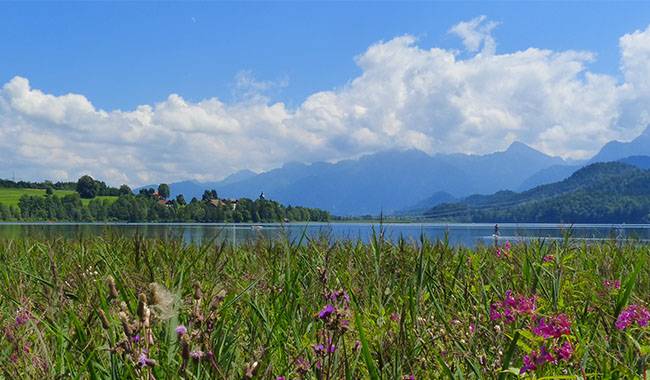
A variety of Balsam flowers are among the many beautiful bedding flowers that adorn any flower garden. They can be appropriately placed in wind-proof and less dark areas around the garden plot. Here are some options for decorating your own garden with these showy flowers
- A very smart and decorative look a vertical bed composed of different shades of Balsam flowers. Such a screen, painted in different colors, will create a cozy atmosphere and decorate a summer rest corner in the garden.
- Along the garden path, these flowers will look great in the flowerbeds.
- Wall hanging pots or wall or floor pots can be decorated with different shades of Balsam flowers wood as a pergola.
- Low-growing flowers in the form of carpets fill the space between trees and shrubs.
- Since Balsam flowers have a long flowering period and a variety of colors, perennial flowers with a shorter flowering period can be used to add spectacular color to the composition.
- Taller varieties will decorate the new mixed borders, the gaps between the still small and not very trailing perennials and shrubs.
- Low-growing cultivars in flower beds can be planted in different shades, and their color schemes can be chosen so that any pattern or color transition creates a gradation.
Fuchsia, verbena, bellflower, and agapanthus will be good companions of Balsam flowers in the bed, and the combination of boxwood and garden Balsam flowers looks interesting.
CULTIVATION AND CARE OF PLANTS
Balsam flowers do not require special care. They are unpretentious plants, perfectly adapted to environmental conditions, with a long flowering time and a large number of flowers. However, like other ornamental plants, they require a certain amount of care. Here are some requirements for the care of Balsam flowers.
MAINTENANCE CONDITIONS
Balsam flowers usually receive a little shade, but in full sun the plant’s foliage becomes brighter and more buds form on the shrub. They are not afraid of direct sunlight, but in the strong shade, the plants will be stretched and bare. They can be planted in hanging pots, deep but not wide garden, and balcony containers and vases with a volume of 0.8 Gal(3 liters) or more.
SOIL AND FERTILIZER
Plant the next crop in any fertile soil. In the case of vases, it is best to line the bottom with crumbs of bricks or swollen clay. Fertilizer is definitely needed when the plants begin to actively grow and bloom. Twice every 30 days, dilute in the water a mineral fertilizer designed for balcony and garden flowers.
WATERING AND MOISTURE
Balsam flowers should be watered frequently and heavily.
- The soil under them should always be moist, but make sure that the water in the bed is not stagnant, otherwise, the plant is in danger of rotting.
- If the plant is a potted perennial, watering should be reduced in winter and the topsoil in the pot should be allowed to dry out completely.
- Also indoor plants need to be sprayed regularly, but make sure that the spray does not get on the buds.
RELATIONSHIP WITH TEMPERATURE
Temperature requirements for indoor plants.
- The ambient air should not fall below 59-64°F (15-18°C), with the most acceptable temperature being 68°F (20°C) above zero. If the temperature drops to plus 55°F (13°C), the plant may die.
- Harden in the spring, taking into account the ambient air temperature, and take the vase with Balsam flowers out onto the balcony.
- Hardy annuals grown in the open are not afraid of strong sunlight, although on particularly hot days the foliage can become a bit peaky and the buds can close. But as soon as the sun starts to go down in the evening, they will come back to life as soon as they are watered under the roots.
Did you know that Balsam (Impatiens balsamina) means “impatience”, indicating that in some flower species, at the slightest touch of ripe fruit, the fruit will split open and the seeds will fly far away?
PROPAGATION AND PLANTING
Balsam flowers are propagated by seeds, but also by cuttings from the upper part of the stem. We will describe the characteristics of each method below.
From seeds
Seeds of Balsam flowers can be purchased in specialized stores, where there is a large selection. When buying, pay attention to the date of their collection, not the date of sale, because old seeds may not take off at all.
Important! Balsam flower seeds can be kept for germination up to 7-8 years, but it is better to plant fresh seeds.
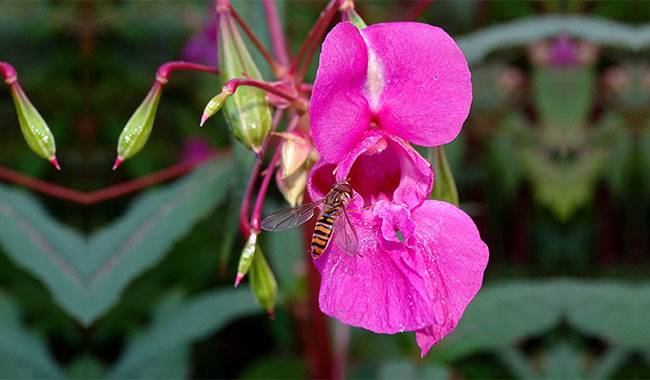
To get your hardy plants to bloom by early summer, sow them in the ground by mid-February.
- To prepare the seeds for sowing, pre-disinfect them with a light manganese solution for 10 minutes, then soak them in clean, warm water for a day.
- For later seedlings, take a 0.13 gal(0.5-liter) plastic cup and pierce small holes in the bottom of the cup for drainage. Fill the bottom of the cup with 0.4-0.8inch (1-2 cm) of fine gravel or clay stones.
- Fill the containers for seedlings with nutrient-rich, light soil. You can buy generic soil at the store, but you can also prepare your own, which consists of the following: one part garden soil, two parts peat moss, one part vermiculite, and one part coarse sand.
- The soil mixture is then watered with a “phytochemical” solution to improve its microflora composition and kill any pathogenic spores that may be present.
- The seeds are very sensitive to light, so they should be sown on a moist soil surface, slightly pressed into the soil, but not submerged to depth.
- Wet the planted seedlings with a sprayer, cover with plastic film, and place on a well-lit, warm windowsill.
7 The temperature of the room where the seeds will germinate should be maintained at 71-77°F (22-25°C).
8 If the temperature and humidity are kept moderate, the first bud should appear in about 20 days. After a single bud appears, the film should be opened twice daily to ventilate the sprouts and shake off any accumulated dew on the film. Excessive humidity is also undesirable as it can expose the seedlings to fungal infestation. - After all the seedlings have emerged (after 5-6 days), remove the bag completely and continue to moisten the soil.
- In the morning, evening, and cloudy days, it is advisable to give the seedlings more light with fluorescent lamps so as not to affect their development.
- Later seedlings are best watered through trays to avoid root neck rot.
- Transplanting seedlings from cups in the open ground, garden containers, or pots should be done after the formation of small clumps and when the roots weave the whole plot into the glass.
- Seedlings should be planted outdoors when there is no threat of frost: mid-May to mid-June, depending on the growing region.
- Plants should be planted at least 10inch (25cm) apart.
THE FOLLOWING STEPS ARE REQUIRED FOR PLANT PROPAGATION
- Select a healthy shoot 3-4 inch (8-10 cm) long from the mother plant and cut it off with a sharp knife.
- Place the cuttings in a container with water and place them on a window sill with light. After a few days, the first roots will appear on the cuttings.
- After the cuttings are rooted, they can be put into small pots – 4 inch (10 cm) in diameter.
- If rooted in spring, a flowering plant will grow from the cuttings of the same summer and will please the owner with lush flowers throughout autumn and winter.
- Rooting in autumn requires increased heat and light.
CARE, DEPENDING ON LOCATION
The care of Balsam flowers should be based on whether it is a house plant or a garden plant. Let’s see what needs to be taken care of in each case.
Important note: Indoor Balsam flowers are rejuvenated every 5 years, otherwise, the flowers will lose their decorative character.
RECOMMENDATIONS FOR THE CARE OF INDOOR FLOWERS
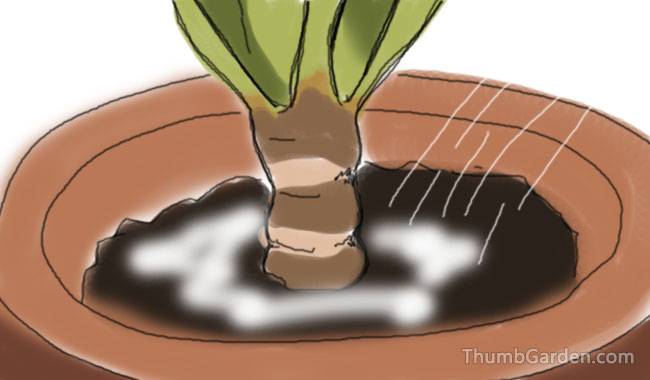
- Balsam flowers are very adaptable to high temperatures, so vases with Balsam flowers can be taken outdoors throughout the summer, under a shade shelter, or under a tree canopy to keep out the sun.
- The temperature regime should not change drastically, so as the autumn days begin, vases need to be brought indoors rather than waiting for a cold snap.
- In winter, the plants feel good in indoor conditions where the temperature does not fall below 53°F (12°C).
- Balsam flowers do not have a dormant period, so from October to the end of March light days are short and it needs an extra light source to bloom in the form of daylight.
- It is very important to fertilize the shrub with compound fertilizer once every two weeks.
- Watering should be done with warm, rainwater.
- Water more in summer and more in winter as the root ball dries out in the vase.
- If the indoor air is dry, the shrub should be sprayed regularly.
- Shrubs should be pruned annually to stimulate the growth of new shoots.
- Bushes should be pushed into larger pots or divided. This is best done in mid-spring.
CARING FOR BALSAM FLOWERS
Gardening Balsam flowers is also easy – even amateur florists can do it. Here are the chores you need to do to grow Balsam flowers outdoors
- Water regularly at night, especially on hot days.
- To keep the soil moist for longer, it should be mulched.
- Weed regularly to remove stray flowers.
- You need to feed potassium and phosphorus twice a month while watering with greywater solution (300 grams of greywater poured in 0.52 gal(2 liters) of boiling water and filled until cool. The solution is then diluted in 2.64 gal(10 liters) of water). Balsam flowers also very much prefer to be sprayed with liquid foliar fertilizer (foliar feeding).
- To form a beautiful bush, young branches should be pruned regularly.
Did you know? In Asian countries, there is a Balsam flower species used as a raw material for the production of henna.
COMMON PROBLEMS IN THE CULTIVATION OF BALSAM FLOWERS
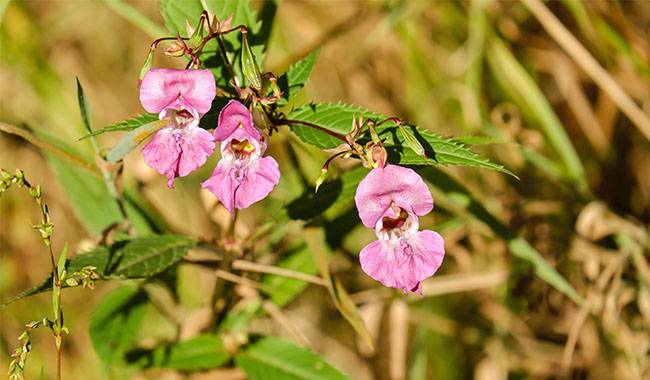
For all the unpretentious care of Balsam flowers during cultivation, certain difficulties can be encountered. Here are some problems, their causes, and solutions.
- The leaves on the shrub are small and pale, and the stems are slender and thin. Cause: The plant is depleted of nutrients due to poorly packed soil, or it may be in a very dark place. Solution: Transplant the plant to a larger pot, or remove the topsoil from the pot and add some fresh, fertile soil. If the problem is due to lack of light, you can move the pot to a brighter place, but not in direct sunlight.
- The shoots are too stretched and bare. Cause: Most varieties of pruned plants tend to stretch. Solution: Regular pruning helps to correct deficiencies. This will stimulate the side shoots and rejuvenate the flowers.
- Few or no flowers. Cause: Lack of nutrients, or conversely, too much nitrogen, makes the buds and leaves grow to the detriment of flowering. Solution: Proper fertilization.
- Curling, dryness, falling leaves. Cause: Indoor air is too hot. It may be potted next to a heater or on a windowsill under the hot sun. Remedy: Move the plant to a cool place and sprinkle water regularly.
- A flower blooms vigorously at the beginning, but then suddenly drops. Cause: Sudden drop in ambient temperature; repotting when in bloom; transferring the root ball to an oversized vase; prolonged dryness in the pot. Remedy: Ensure optimum temperature; do not transplant the plant during flowering; transplant the flowers to a vase slightly larger than the previous one; do not forget to water and sprinkle regularly.
- The mottled shrub has lost its color. Cause: The flowers do not receive enough light. Solution: These varieties need more sunlight than others, therefore, adequate sunlight needs to be provided.
Balsam flowers look great in hanging pots. Geraniums, verbena, larkspur, petunias, sundews, daffodils, lobelia and begonias are the best plants for hanging pots.
PESTS AND PREVENTION
The following is an overview of the main pests and diseases of Balsam flower mosaics, their control methods, and preventive measures.
Balsam flowers mosaic: The young leaves are affected and the young leaves are covered with yellow spots, after which they become deformed. The spots are able to proliferate, yellowing completely covering the leaves and then descending to the stem, leading to unilateral necrosis. The bush stops developing and dies.
The cause of the disease is a virus transmitted by thrips or mites. Eradication: Treating the flowers is no longer useful, so prevention is important. Prevention consists of intensive care and spraying with insecticides. Affected plants must be destroyed.
Gray rot: A fungus that affects leaves and shoots with brown spots that are later covered with gray patches of fungal spores. As a result, the plant dies. Infested water or soil may be the cause. Infection can be caused by watering too cold or by air currents, or by weakening the plant due to refrigeration.
Prevention: Proper preventive care, watering with warm, clean water, indoor ventilation, creating the right temperature, and keeping the air clean.
Also, at the first symptoms (first spots on the leaves), it is best to cut off the affected leaves immediately, transplant the shrub to other soil, and spray with a multi-purpose systemic fungicide.
Bacterial disease: Watery spots appear on leaves and shoots, which then turn brown and cover all the leaves. After that, the plant dies. Caused by contaminated soil, too much water and fertilizer, and high temperatures. The first time you see the spots, remove them immediately by spraying the healthy parts of the plant with a copper-rich product or a fungicide (Bordeaux mixture). If the disease spreads too quickly, it is best to isolate or destroy the flowers.
Powdery mildew: White patches appear on the leaves and then affect the entire shrub. The causes are the poor circulation of fresh air indoors, disrupted feeding and watering schedules, insufficient light and temperature fluctuations.
Remedy: Remove diseased leaves and spray with a solution of soda ash – 2 grams of soda ash per 0.26 gal(1 liter) of water. The use of fungicides also helps well. In addition, it is necessary to correct the care of the plant.
Spider mites: A spider mite is entangled in the lower part of the leaf. This is caused by too dry air. Remedy: Spray the plant with a soap solution, or wipe the leaves with alcohol, or use a special preparation. Don’t forget to maintain the right humidity for the flower.
In summary, it can be stressed that despite the above-mentioned problems and diseases of Balsam flowers, if all the requirements are followed for planting and caring for these flowers and plants, you can enjoy bright flowers growing on windowsills and in summer flower beds all year round.
More Related Information About Planting & Growing Flowers




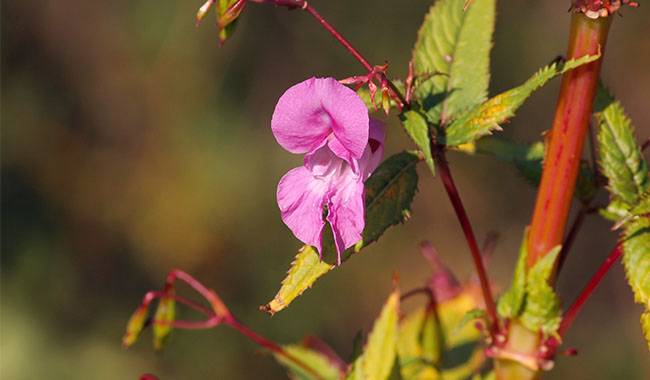
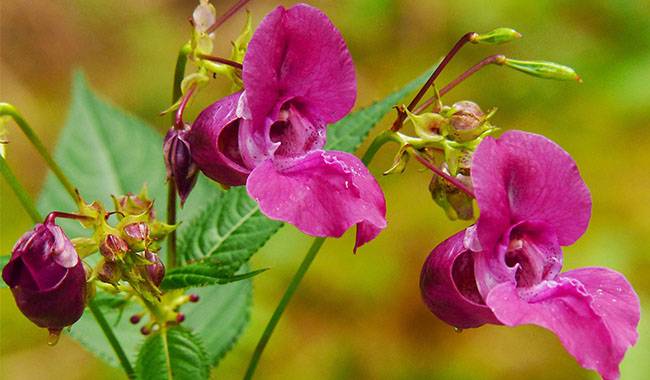
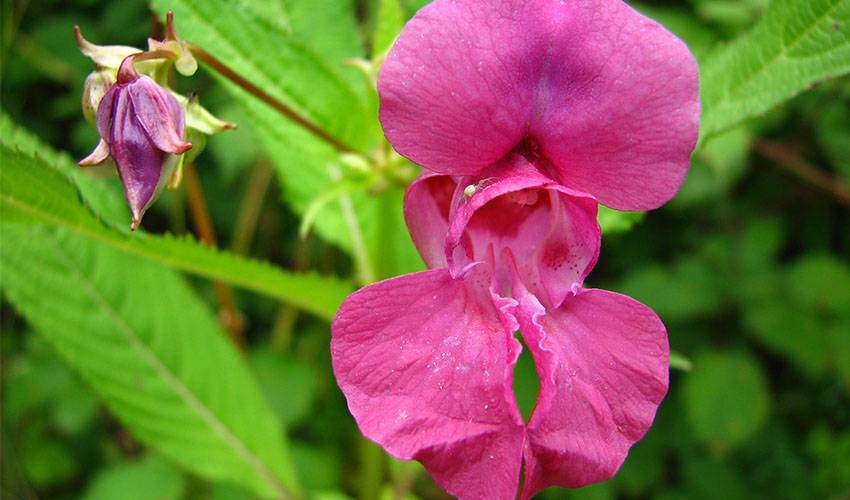
I have lot balSams along the border and found your article useful. I live in the tropics, India and by and large they ate doing well. I was interested to know how tho make them bushy.
Thank you for your message, please do share your result with us after you following the step from this article. You Are sharing it’s a big motivation to us.